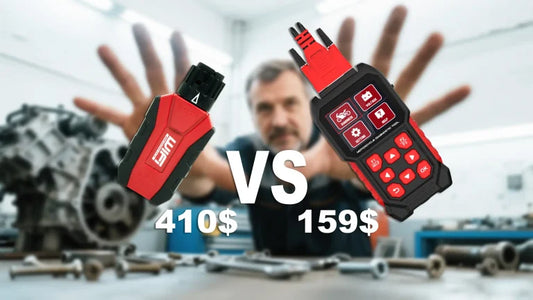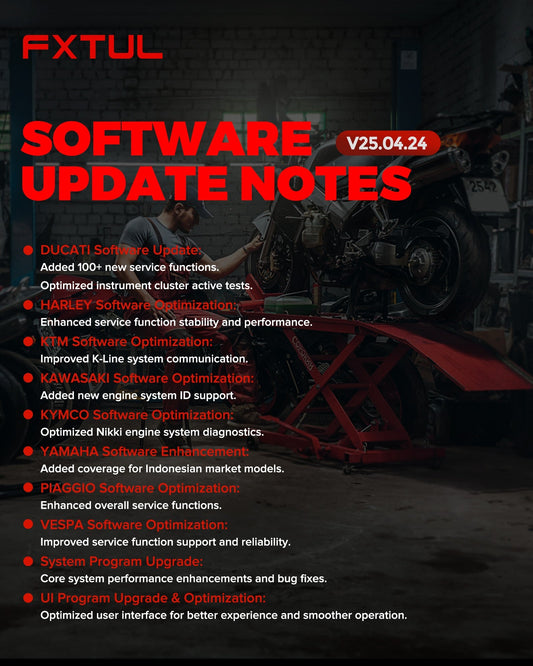Riders of the Yamaha R3 are often most concerned when the dashboard suddenly lights up with fault codes. A bunch of P-codes and U-codes can leave them baffled, and a visit to the dealership might turn out to be just a minor issue that gets exaggerated... This article will provide a detailed explanation of common fault codes for the R3 and their corresponding causes, and show how to quickly and accurately identify the problem using a professional motorcycle diagnostic tool, even allowing you to clear the codes yourself.
Note: After troubleshooting the faults, please use the diagnostic tool to clear the fault codes from the ECU.
Fault Code - Cause and Resolution
P0030: Check the oxygen sensor and confirm whether a fault has occurred due to a mismatch between the heater or driver circuit ON/OFF command and error signals. Please resolve accordingly.
P00D1: Check the oxygen sensor and confirm whether a fault has occurred due to poor heater performance. Please resolve accordingly.
P0107: Check the intake pressure sensor and confirm whether a short circuit to ground has occurred. Please resolve accordingly.
P0108: Check the intake pressure sensor and confirm whether a circuit break or short circuit to power has occurred. Please resolve accordingly.
P0112: Check the intake temperature sensor and confirm whether a short circuit to ground has occurred. Please resolve accordingly.
P0113: Check the intake temperature sensor and confirm whether a circuit break or short circuit to power has occurred. Please resolve accordingly.
P0117: Check the coolant temperature sensor and confirm whether a short circuit to ground has occurred. Please resolve accordingly.
P0118: Check the coolant temperature sensor and confirm whether a circuit break or short circuit to power has occurred. Please resolve accordingly.
P0122: Check the throttle position sensor and confirm whether a circuit break or short circuit to ground has occurred. Please resolve accordingly.
P0123: Check the throttle position sensor and confirm whether a short circuit to power has occurred. Please resolve accordingly.
P0132: Check the oxygen sensor and confirm whether a short circuit to power has occurred. Please resolve accordingly.
P0201: Check the injector of cylinder 1 and confirm whether a fault in the injector has occurred. Please resolve accordingly.
P0202: Check the injector of cylinder 2 and confirm whether a fault in the injector has occurred. Please resolve accordingly.
P0335: Check the crankshaft position sensor and confirm whether a fault has occurred due to the absence of a normal signal from the crankshaft position sensor. Please resolve accordingly.
P0351: Check the ignition coil of cylinder 1 and confirm whether a fault has occurred due to the absence of a normal signal from the ignition system circuit. Please resolve accordingly.
P0352: Check the ignition coil of cylinder 2 and confirm whether a fault has occurred due to the absence of a normal signal from the ignition system circuit. Please resolve accordingly.
P0480: Check the radiator fan motor relay and confirm whether a fault has occurred due to the absence of a normal signal from the radiator fan motor relay. Please resolve accordingly.
P0507: Confirm if you hear the ISC (Idle Speed Control) unit operating sound: check other components besides the ISC for any faults and resolve accordingly.
P0507: Confirm if you do not hear the ISC (Idle Speed Control) unit operating sound: check the ISC for any faults and resolve accordingly.
P0511: Check the ISC (Idle Speed Control) unit and confirm whether a fault has occurred. Please resolve accordingly.
P0560: Check the battery voltage and confirm whether a discharge fault has occurred. Please resolve accordingly.
P0563: Check the battery voltage and confirm whether an overcharge fault has occurred. Please resolve accordingly.
P0601: Check the ECU and confirm whether an internal fault has occurred (the diagnostic tool may not display the fault code number after detecting this issue). Please resolve accordingly.
P062F: Check the ECU and confirm whether a fault has occurred due to an error detected while reading or writing to the EEPROM. Please resolve accordingly.
P0657: Check the gasoline system voltage and confirm whether an improper supply voltage to the fuel pump relay, injectors, and fuel pump has occurred. Please resolve accordingly.
P1400: Check the AI solenoid valve and confirm whether a fault has occurred due to a detected open circuit or short circuit. Please resolve accordingly.
P1500: Check the rear wheel sensor and confirm whether a fault has occurred due to not receiving a normal signal from the rear wheel sensor. Please resolve accordingly.
P1500: Check the neutral switch and confirm whether a circuit break or short circuit has occurred. Please resolve accordingly.
P1500: Check the clutch switch and confirm whether a circuit break or short circuit has occurred. Please resolve accordingly.
P1601: Check the side stand switch and confirm whether a fault has occurred due to not receiving a normal signal from the relevant switch. Please resolve accordingly.
P1602: Check the internal circuit of the ECU and confirm whether a fault has occurred (ECU power-off function is abnormal). Please resolve accordingly.
P1604: Check the tip-over sensor and confirm whether a short circuit to ground has occurred. Please resolve accordingly.
P1605: Check the tip-over sensor and confirm whether a circuit break or short circuit to power has occurred. Please resolve accordingly.
P2195: Check the oxygen sensor and confirm whether a fault has occurred due to a detected circuit break. Please resolve accordingly.
How to Identify the Problem and Clear Fault Codes?
Identifying fault codes is just the starting point. To determine whether it's a wiring issue or a faulty sensor, you need to check the real-time data.
Manually troubleshooting these circuit issues can be very tedious, as it requires using a multimeter to measure step by step, which is time-consuming. A more efficient method is to use a professional diagnostic tool to read the real-time data stream from the ECU.
For example, with a throttle position sensor (TPS) fault (P0120), you can enter the "Data Stream" function on the FXTUL M7 diagnostic tool to directly view the TPS's percentage of throttle opening and voltage signal. When twisting the throttle, the value should change smoothly and linearly. If the value fluctuates, gets stuck, or remains at 0, it's likely a sensor or wiring issue. This approach is much more intuitive and accurate than blindly testing with a multimeter.
Additionally, the FXTUL M7 also features an active actuator test function, which allows you to actively control components such as the fuel injectors, fuel pump, and ignition coils while the engine is off. You can test their performance individually, making it an invaluable tool for diagnosing issues like "no spark" or "no fuel injection.
After clearing the fault codes, you probably want to check if the issue reappears by taking a ride. The FXTUL M7 supports one-click fault code clearing, and once cleared, you can immediately read the status of all systems. You can then go on a test ride and monitor in real-time whether the fault codes reappear.
Of course, you can also use methods like short-circuiting the TC and DLC diagnostic interfaces to flash the codes. However, this method only allows you to read the codes—it doesn't provide data streams, can't perform active tests, and can't clear fault codes from systems like the electronic throttle. Tools like the FXTUL M7, on the other hand, offer a full range of features.
The FXTUL M7 is specifically designed for fuel-injected motorcycles, with comprehensive protocol support for brands such as BMW, Yamaha, Kawasaki, Harley-Davidson, Piaggio, and more. It boasts a high decoding success rate, ensuring no garbled data or unrecognized codes.
Conclusion
If you're troubled by motorcycle fault issues and looking for a diagnostic tool at the level of a professional mechanic, consider checking out our FXTUL M7 Motorcycle Scanner.
Click the link below to view the detailed features of the FXTUL M7 and read real reviews from many fellow riders >>
Buy now and enjoy a 20% discount for the first 50 customers. Get discount code>>
"Have questions about fault codes? Feel free to leave a comment or contact our online customer service for assistance."




